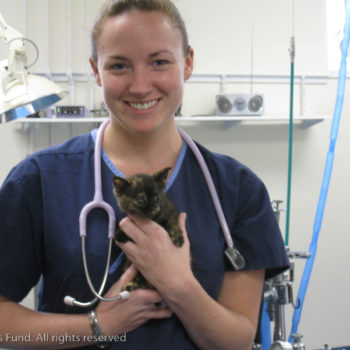If you’ve adopted a pet from an animal shelter or rescue group, you know how powerful the bond is that exists between the pet and their human family. You’re also probably aware of the efforts made by shelter and rescue staff and volunteers to make sure you and your pet found each other. What you may not know is that shelter medicine made that happy ending possible for both of you.
To understand the importance of shelter medicine for homeless pets and the people who adopt them, you’ll need to look back in time to 1970, when around 23 million dogs and cats lost their lives in U.S. animal shelters every year. The number of pets coming into shelters was so high, and the likelihood the pet would be adopted so low, that shelter pets were rarely offered veterinary treatment; even preventive care, such as vaccination, was rare.
Now for some good news. By the 1990s, shelter intake had been drastically reduced. The number of pets who did not leave U.S. shelters alive dropped to 6 million in 1996, and the status of companion animals was on the rise, as was the number of people who chose to adopt over other means of acquiring a pet.
At this critical moment in sheltering history, very few animal shelters had veterinarians on staff for anything other than performing spay/neuter surgery. That’s when the ASPCA and Cornell University partnered to offer the very first shelter medicine course for veterinary students, and Maddie’s Fund® established the country’s first shelter medicine residency program at the UC Davis School of Veterinary Medicine.
Today, the landscape has changed. The number of dogs and cats not currently being adopted from shelters each year has dropped to 3.4 million from 1970’s 23 million, with around 29 million households seeking to add a new pet to the family each year.
Shelter medicine is a recognized veterinary specialty, and nearly all large shelters have veterinary professionals providing care to the pets in the facility. Advances in housing, disease prevention, and how shelters respond to disease outbreaks, along with a growing focus on making animal shelters less stressful for pets, has helped increase the number of pets who are adopted into loving homes.
What did shelter medicine do to save your pet for you?
- Conducted extensive research into how animal shelters can prevent disease outbreaks
- Explored the effect of different types of housing and how it can keep pets healthier and happier while in the shelter
- Established best practices and protocols for high quality, high volume spay/neuter
- Developed the concept of individualized pathways through the shelter to a foster home, adoption, or return to habitat
- Created university courses, both on-campus and online, to train veterinary students and veterinarians in caring for shelter and rescue group pets
- Built a safety net of testing and isolation to prevent the needless euthanasia of pets in shelters during a disease outbreak
- Wrote and published the Association of Shelter Veterinarians Guidelines for Standards of Care in Animal Shelters, providing comprehensive information on how to ensure animals in shelters are not exposed to disease, stress and suffering while awaiting adoption
Through all these initiatives and more, shelter medicine creates the opportunity to save more lives in every shelter, in every community. It makes adoptions possible, prevents and treats suffering, and helps create loving families for pets who not all that long ago wouldn’t have had a chance.
When you adopted your pet, they were rescued by your love. Before they came to you, they were saved by shelter medicine.
Learn more at Shelter Medicine Changes Everything.

